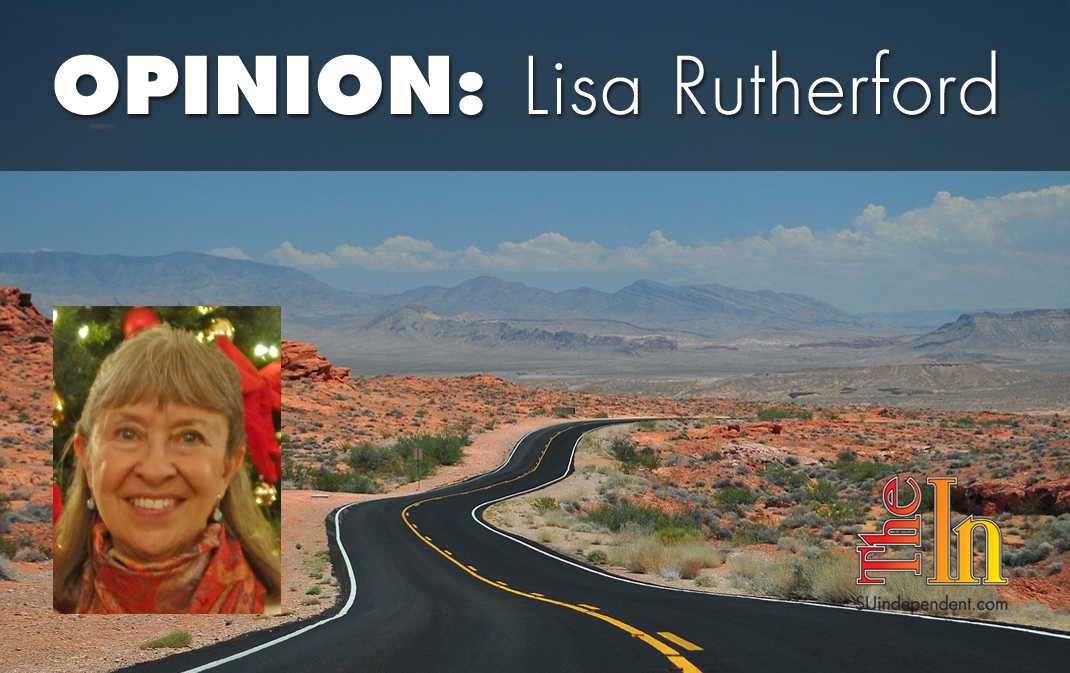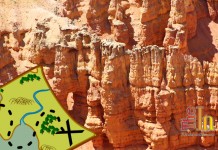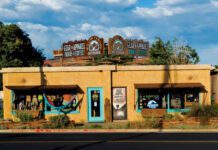
Longing for reasonable leaders of the ‘90s
Bills H.R. 5597 and H.R. 3297 would force the Northern Corridor/Washington Parkway though the heart of our Red Cliffs Desert Reserve
Our environmental laws that have been in place for over 40 years are under attack. Those laws passed Congress with votes from both Republicans and Democrats. Now attacks on the National Environmental Policy Act, the Environmental Protection Act, and the Endangered Species Act seem to be daily occurrences.
Several different bills attempt to undermine the Endangered Species Act by requiring that potential economic consequences be considered and give state and local governments more control over science and management decisions. Two current bills — Congressman Stewart’s H.R. 5597 and Sen. Lee’s sister bill, H.R. 3297, also known as the “Washington County, Utah, Public Land Act” — attempt to undo decisions, made in good faith in keeping with the Endangered Species Act, to create our Red Cliffs Desert Reserve over 20 years ago.
Although the Endangered Species Act may need some minor tweaking, as I watch current efforts to unravel the environmental law under which we have existed since the ‘70s, I long for those county leaders — political and property owners — who were involved in the establishment of our Red Cliffs Desert Reserve (to protect Mojave desert tortoise and other species) in the mid ‘90s. County leaders who worked diligently to make the Red Cliffs Desert Reserve a reality did not go back to D.C. as our current leaders are doing to change the laws — and yet, they those diligent county leaders understood the realities of a county that had been doubling its population every 10 years with no signs of that stopping on the horizon.
I understand the balance of political power in D.C. in the ‘90s and that Utah’s current generation of local, state, and national leaders now feel that they have the wind at their backs and can turn the clock back to a time when pesky environmental laws would not impede their growth agenda.
But has the Endangered Species Act held back growth in Washington County?
We’ve seen this area prosper even with the 61,000-acre Red Cliffs Desert Reserve, now mostly a National Conservation Area, which affords additional protection — at least, so far. We’ve watched Washington County become the fastest growing area in this nation. An average 6 percent growth rate has allowed Washington County to more or less double its population every 10 years.
How much faster do Stewart, Lee, Bishop, and local leaders want to see this area grow? What is their agenda for this growth pressure?
The fact is that leaders in the ‘90s, when growth was great, could have fought harder against demands by the U.S. Fish and Wildlife Service and the Endangered Species Act to create the Red Cliffs Desert Reserve by demanding a highway through it. Perhaps then they could have used other tortoise “infested” areas in Washington County to mitigate for the road acres.
However, they did not.
Apparently, they realized that by establishing 61,000 contiguous acres as protected habitat, growth could occur throughout Washington County, as we have clearly seen happen. The funny — and sad — thing is that the proposed Northern Corridor/Washington Parkway through the heart of the Red Cliffs Desert Reserve/National Conservation Area will not solve Washington County’s transportation problems. It will only be a $110 million band-aid.
The leaders of the ‘90s are gone — or at least not in power — and now Utah’s leaders are working to reverse decades of environmental laws that were established for good reasons: species extinction, polluted rivers, the proliferation of pesticide use, and more.
Do we really want to return to those days? Do your children and grandchildren really want to face that reality?
Love Canal had an estimated 21,000 tons of waste dumped there. Acid rain was caused by the interaction of fossil-fuel emissions with sunlight, oxygen, and hydrogen chloride, causing an acidic condition mostly seen in highly industrialized areas, damaged buildings, and forests. A river actually caught fire due to oil and debris that collected on the surface.
Then there was the chemical pollution caused by pesticides, particularly DDT, that polluted the air and water, resulting in near extinction of animals including bald eagles. We still have thousands of contaminated sites that resulted from hazardous waste being improperly managed. We still have species that need protection.
Congressman Bishop argued in Congress that the Endangered Species Act has a paltry success rate; only 3 percent of species have been delisted. Is that really a reason to undo the entire process?
Perhaps a better way of looking at the situation is this: Of the more than 1,800 species list as endangered or threatened in the U.S., only 1 percent have been declared extinct under the Endangered Species Act, and many are on the path to recovery.
Additionally, the Center for Biological Diversity asserts that 90 percent of species are recovering at the rate specified by the federal recovery plan.” In fact, many species have not been given the time prescribed in their recovery plans. Species have on average been listed for 32 years, but their recovery plans require 46 years for success. How can the process be evaluated when the time frame is cut short? That said, some species have recovered in time shorter than that which was prescribed for them.
Our Red Cliffs Desert Reserve/National Conservation Area’s Mojave Desert tortoise population does not need to have its recovery impacted by a highway built through its prime habitat, Zone 3. Leaders assert that addition of a new zone, Zone 6, will help because of the tortoises there. But survey methodology used to survey both zones is different and comparison of tortoise populations questionable. In any case, Zone 6 tortoises should be protected because of their status, not used as bargaining chips.
Utah’s Sen. Mike Lee and Congressman Chris Stewart’s bills H.R. 5597 and H.R. 3297 would force the Northern Corridor/Washington Parkway though the heart of our Red Cliffs Desert Reserve/National Conservation Area, ignoring Endangered Species Act protection requirements for the threatened Mojave Desert tortoise and other threatened and endangered species in the area.
If you, too, are concerned about the changes I’ve addressed in this column and their bills, H.R. 5597 and H.R. 3297 — please contact Sen. Lee and Congressman Stewart and express your concerns. And don’t delay.
Bills that attempt to undo our environmental laws would not only stop conservation and environmental groups from suing to protect species but would also remove National Environmental Policy Act requirements for a public process that engages you, me, and all citizens in a process that helps to determine the fate of our air, water, and landscapes and the species with which we share this Earth. Thank you to the leaders of the ‘90s and before, and shame on today’s leaders who are pushing this agenda.
Articles related to “Longing for reasonable leaders of the ‘90s”
Does Utah actually have a remaining Colorado River water right?
The viewpoints expressed above are those of the author and do not necessarily reflect those of The Independent.
How to submit an article, guest opinion piece, or letter to the editor to The Independent
Do you have something to say? Want your voice to be heard by thousands of readers? Send The Independent your letter to the editor or guest opinion piece. All submissions will be considered for publication by our editorial staff. If your letter or editorial is accepted, it will run on suindependent.com, and we’ll promote it through all of our social media channels. We may even decide to include it in our monthly print edition. Just follow our simple submission guidelines and make your voice heard:
—Submissions should be between 300 and 1,500 words.
—Submissions must be sent to editor@infowest.com as a .doc, .docx, .txt, or .rtf file.
—The subject line of the email containing your submission should read “Letter to the editor.”
—Attach your name to both the email and the document file (we don’t run anonymous letters).
—If you have a photo or image you’d like us to use and it’s in .jpg format, at least 1200 X 754 pixels large, and your intellectual property (you own the copyright), feel free to attach it as well, though we reserve the right to choose a different image.
—If you are on Twitter and would like a shout-out when your piece or letter is published, include that in your correspondence and we’ll give you a mention at the time of publication.




The politicians involved don’t care, nor will they listen. They have made up their minds. This is about money, and the tortoises represent an obstacle and are insignificant to these politicians. This is a payoff and nothing is going to stop it but a mass uprising. Since that is not going to happen, or is unlikely to happen, little can be done. I have done my part, and expressed my opinion as much as possible on other media platforms, as well as written emails directly. The tortoises in the area will at least be relocated, but in the end big $ will rule the day. We do not need this highway. But politicians need donations from construction companies. Eventually, in 20 years they will zone parts of it for housing and commercial developments. That’s if we make it that far. Great article, and I hope I am wrong.
Fulcanelli, I hope you’re wrong, too, but only time will tell. We have to keep fighting against wrong-headed decisions. Thanks for your efforts to try and convince current leaders that there are other options that should be evaluated before building a highway with tax money when the road won’t even do what they think it will do. We do have a lot of dense leaders; that’s for sure! Living in this fast-growing area has given them a very inflated opinion of themselves when they are little more than emperors without clothes, as the story goes. Others see their nakedness but they don’t and most are afraid to tell them. Hang in there.